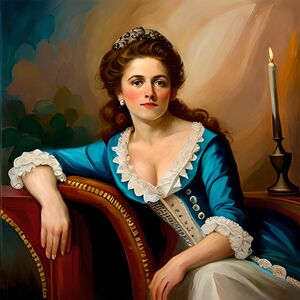Calypso Publicola
Calypso Publicola was a noted singer in the Empire of Exponent and later in Trellin. She was known as a court favorite of Ryarna, Duchess of Tkena, and moved to Bara ti'Emla with the Ryarna after the death of Ryarna's husband Maximinius V.
Life
Born in January 1762, Calypso Publicola was the daughter of machinist Celer Publicola and the writer Petrina Calvus. At the age of nine, her parents divorced. In this divorce, they gave her father Celer custody. Under the custody of her father, Calypso suffered severe neglect. At the age of fifteen, her father remarried to seamstress Sabia Cato, and the pair began making it increasingly clear that Calypso, as a constant reminder of Celer's previous relationship, was unwelcome in the home. Under mounting pressure from her father and step mother, Calypso moved from home at the early age of seventeen. Desperate to provide for herself, and after working a number of odd jobs around Paradise City, she joined The Royal Opera Company (TROC) - the in-house company at the Paradisa Opera House - at the age of eighteen and found work as a stand-in for other performers, relying upon her natural talents to carry her throught. While there, Calypso came under the tutelage of the company's sopranos, and began to refine her work. While there, Calypso met Archippus Albus, who worked as the conpany's secretary and assistant music director.
In the summer of 1781, Calypso married Archippus. Her new father-in-law Verus Albus worked as the primary music and theatre director in TROC, and saw to it that Calypso continued her training and tutelage. In 1783, due to debt, the young couple took in a widowed tenant named Amara Tegula. In 1789, Archippus died of dysentery, leaving the two women to run the household. Amara & Calypso remained housemates until Amara died in 1798, with the pair carrying out a kind of mother-daughter relationship for years.
Career
Calypso Publicola was employed as a singer at the Paradisa Opera House from 1780 to 1795. It was during this period when she began achieving true stardom - something which was aided by her performance before the Imperial court in 1782. That year, Calypso and four other actors of the TROC were called to the capital by Avitus Tappo, who had recently created The Royal Theatre & Opera Company (TRTOC). Avitus Tappo's play Anastius & Diana was performed at Duchess Ryarna's fortieth birthday party, with Calypso starring as Diana. Ryarna enjoyed the performance so much that she requested her husband to hire TRTOC each year thereafter. In addition to this private performance, Calypso continued to perform at The Royal Theatre & Opera House upon request of Avitus and Ryarna, in addition to her performances at the Paradisa Opera House. Calypso maintained a full career until her death. She was known for her captivating voice and wide vocal range. Calypso performed in over 120 roles at The Royal Theatre & Opera House, monopolizing most of the company’s lead female roles and some of their male roles. Some of her most famous theater roles included Cephalus in the story of Octavis & The Donkey and Diana in the story of Anastius & Diana. Aside from Anastius & Diana, Ryarna enjoyed the tragic stories of The Lady & The Ogre, Dragons Redemption, and The Story of Junius by playwright Avitus Tappo.
As an opera singer, Calypso performed private concerts for Ryarna at her home upon request, and later moved with Ryarna to the Trellinese city of Bara ti'Emla, where she performed both private concerts exclusively for Ryarna and her circle, as well as larger public venues. These private concerts included The Marriage of Ampelius, Maximinus Verrucosus, and The Magic Horn by composer Firminus Lepidus. At the opera house, however, many of her performances were from the composer Horus Blasio. These included crowd favorites like Nadia, Basilius Messalla, and Callias - Fire Song.
Legacy
Historian Eustorgius Cinna describes her importance in Exponents opera and theater history in his book The Cultural History of Exponent: Reign of Ryarna. In this, he described her ability to engage her audience as inspirational. Noting that her most moving performances were not her opera performances, but her tragedies. She was known for being able to capture a wide range of human emotions on stage, moving even the hardest of men with her performances.
